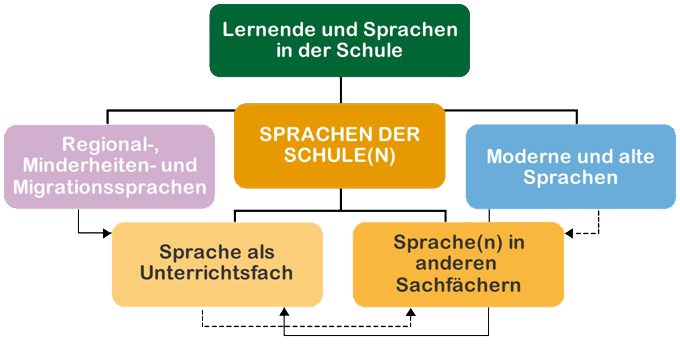Einstieg ins Thema
Schulische Gesamtsprachencurricula beruhen auf dem Gedanken, dass Sprachen so unterrichtet werden, dass sie mit Sachfächern in Verbindung stehen. Das Unterrichten der Sprach- und Sachfächer findet in enger Kooperation miteinander statt, so dass alle Fächer auch sprachliche Aspekte behandeln. In allen Sachfächern soll dieses sogenannte integrierte Sachfach- und Sprachenlernen konsequent umgesetzt werden.
Auf diesen Seiten möchten wir Sie über Aktivitäten informieren, die Partnerschulen während der Projektlaufzeit von PlurCur durchgeführt haben. An einigen dieser Schulen sind die Projektaktivitäten inzwischen regulärer Bestandteil des Schullebens.
Hier sind Beispiele für Schulprojekte, die auf der Website vorgestellt werden:
Zur Bedeutung von Gesamtsprachencurricula in der Sprachenbildung
PlurCur zielt auf einen umfassenden Ansatz zum Sprachenlernen in Schulen ab. Alle gesprochenen, bekannten und gelernten Sprachen sollen einbezogen werden.
Dies betrifft insbesondere folgende Sprachen:
- die “Bildungssprache” - in der Regel die Amtssprache(n) des betreffenden Landes oder der Region (zum Beispiel Französisch in Frankreich);
- Sprachen, die von den Schülerinnen und Schülern zu Hause gesprochen werden (zum Beispiel eine Migrationssprache);
- Fremdsprachen, die in der Schule unterrichtet werden (zum Beispiel Englischunterricht in Polen)
- und in einigen Fällen klassische Sprachen wie Latein und Griechisch
- sowie die Sprachen die im Unterrichtet von Sachfächern verwendet werden (zum Beispiel Deutsch als Unterrichtssprache im naturwissenschaftlichen Unterricht in Rumänien).

Weitere Informationen zu diesem Thema: Platform of resources and references
for plurilingual and intercultural education, Europarat.
Lernende entwickeln ihre eigenes "Repertoire" in den verschiedenen Sprachen, die sie kennen und verwenden. Die Kompetenzen, die in einer Sprache erworben werden, können beim Erlernen einer anderen Sprache von Nutzen sein. Es entsteht ein dynamisches Wechselspiel und die Sprachen, die für die Lernenden unterschiedliche Bedeutung haben, ergänzen einander.
Gesamtsprachencurricula schaffen Synergien zwischen dem Lehren und Lernen der nationalen / regionalen Sprache, den verschiedenen Fremdsprachen und anderen Sprachen in den Schulen. Lernende entwickeln ein Bewusstsein für Mehrsprachigkeit und für die konkreten Gelegenheiten ein mehrsprachiges Repertoire aufzubauen. Die PlurCur-Webseite zeigt verschiedene Wege, wie dies erreicht werden kann.